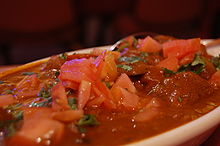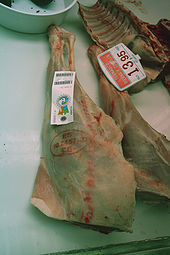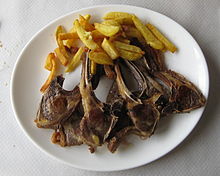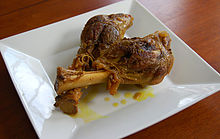- Lamb and mutton
-
"Mutton" redirects here. For goat meat used interchangeably with mutton, see Goat meat. For other uses, see Mutton (disambiguation).
Lamb, mutton, and hogget (UK, New Zealand and Australia)[1][2] are the meat of domestic sheep. The meat of a sheep in its first year is lamb; that of a juvenile sheep older than 1 year is hogget; and the meat of an adult sheep is mutton.
Distinct from the meat, a lamb (with the indefinite article) also describes a live juvenile sheep (species Ovis aries), which may or may not be used for its meat. In Australia, the term prime lamb is often used to refer to lambs raised for meat.[3]
Contents
Classifications and nomenclature
The strict definitions for lamb, hogget and mutton vary considerably between countries. In New Zealand for example, they are defined as follows:
- Lamb — a young sheep under 12 months of age which does not have any permanent incisor teeth in wear
- Hogget — a sheep of either sex having no more than two permanent incisors in wear[4]
- Mutton — a female (ewe) or castrated male (wether) sheep having more than two permanent incisors in wear.
In Australia the definitions are extended to include ewes and rams, as well as being stricter on the definition for lamb which is:
- Lamb — 0 permanent incisors; female or castrate entire male ovine 0–12 months (note that the Australian definition requires 0 permanent incisors, whereas the New Zealand definition allows 0 incisors 'in wear'.)
Under current United States federal regulations, only the term 'lamb' is used:
- Lamb — ovine animals of any age, including ewes and rams[5]
The term 'mutton' is rare,[citation needed] and 'hogget' unknown,[6] in the United States.
Younger lambs are smaller and more tender. Mutton is meat from a sheep over two years old, and has a less tender flesh. In general, the darker the colour, the older the animal. Baby lamb meat will be pale pink, while regular lamb is pinkish-red.
Other definitions include:
- Lamb — a young sheep that is less than one year old
- Baby lamb — a milk-fed lamb between six and eight weeks old
- Spring lamb — a milk-fed lamb, usually three to five months old, born in late winter or early spring and sold usually before July 1
- Yearling lamb — a young sheep between 12 and 24 months old.
- Milk-fed lamb — meat from an unweaned lamb, typically 4 to 6 weeks old and weighing 5.5 to 8 kg; this is almost unavailable in countries such as the USA and the UK, where it is considered uneconomic. The flavour and texture of milk-fed lamb when grilled (such as the tiny lamb chops known as chuletillas in Spain) or roasted (lechazo asado or cordero lechal asado) is generally thought to be finer than that of older lamb. The areas in northern Spain where this can be found include Asturias, Cantabria, Castile and León, and La Rioja. Milk-fed lambs (and kids) are especially prized for Easter in Greece, when they are roasted on a spit.
- Sucker lambs — a term used in Australia[7] — includes young milk-fed lambs as well as slightly older lambs up to about 7 months of age which are also still dependent on their mothers for milk. Carcases from these lambs usually weigh between 14 and 30 kg. Older weaned lambs which have not yet matured to become mutton are known as old-season lambs.
- Saltbush mutton - a term used in Australia for the meat of mature Merinos which have been allowed to graze on atriplex plants.
- Salt marsh lamb (also known as 'saltmarsh lamb' or by its French name, agneau de pré-salé) — the meat of sheep which graze on salt marsh in coastal estuaries that are washed by the tides and support a range of salt-tolerant grasses and herbs such as samphire, sparta grass, sorrel and sea lavender. Depending on where in the world the salt marsh is located, the nature of the plants may be subtly different. Salt marsh lamb has long been appreciated in France and is growing in popularity in the United Kingdom. Places where salt marsh lamb are reared in the UK include Harlech and the Gower Peninsula in Wales, the Somerset Levels and Morecambe Bay.[8]
In many Eastern countries including the Indian sub-continent, Malaysia and Singapore, the term mutton refers to goats' meat (which is properly called chevon) and usually not to sheep's meat. Often, the mutton curries of the Indian cuisine use goat meat when cooked at home.
Butchery and cookery
 Mutton Rogan Josh from India.
Mutton Rogan Josh from India.
 Barbecued lamb sticks
Barbecued lamb sticks
 2 rolls of lamb roti roll
2 rolls of lamb roti roll
The meat of a lamb is taken from the animal between one month and one year old, with a carcase (carcass in American English) weight of between 5.5 and 30 kilograms (12 and 65 lbs). This meat generally is more tender than that from older sheep and appears more often on tables in some Western countries. Hogget and mutton have a stronger flavour than lamb because they contain a higher concentration of species-characteristic fatty acids and are preferred by some.[9] Mutton and hogget also tend to be tougher than lamb (because of connective tissue maturation) and are therefore better suited to casserole-style cooking, as in Lancashire hotpot, for example.
Lamb is often sorted into three kinds of meat: forequarter, loin, and hindquarter. The forequarter includes the neck, shoulder, front legs, and the ribs up to the shoulder blade. The hindquarter includes the rear legs and hip. The loin includes the ribs between the two.
Lamb chops are cut from the rib, loin, and shoulder areas. The rib chops include a rib bone; the loin chops include only a chine bone. Shoulder chops are usually considered inferior to loin chops; both kinds of chop are usually grilled. Breast of lamb (baby chops) can be cooked in an oven.
Leg of lamb is a whole leg; saddle of lamb is the two loins with the hip. Leg and saddle are usually roasted, though the leg is sometimes boiled. Roasted leg and saddle may be served anywhere from rare to well-done.
Forequarter meat of sheep, as of other mammals, includes more connective tissue than some other cuts, and, if not from a young lamb, is best cooked slowly using either a moist method, such as braising or stewing, or by slow roasting or American barbecuing. It is, in some countries, sold pre-chopped or diced.
Lamb shank definitions vary, but generally include:
- Lamb shank is cut from the arm of shoulder, contains leg bone and part of round shoulder bone, and is covered by a thin layer of fat and fell (a thin, paperlike covering).
- Lamb shank is a cut of meat from the upper part of the leg.
According to Jewish Kosher law, sheep may be eaten but as with cows, they must be killed while conscious and the sciatic nerve, as well as certain types of fat on the back half of the animal, may not be eaten. This makes certain cuts, such as leg or steaks, very difficult to produce in some countries. Similar rules apply for the Islamic dietary code, Halal.
Thin strips of fatty mutton can be cut into a substitute for bacon called macon.
Cuts
Australia, UK and Canada
Approximate zones of the usual UK cuts of lamb:[10]
- Scrag end (of neck)
- Middle neck
- Best end (of neck)
- Loin
- Chump (and chump chops)
- Leg (gigot in Scotland)
- Shank
- Shoulder
- Breast
USA
- Square cut shoulder – shoulder roast, shoulder chops and arm chops
- Rack – rib chops and riblets, rib roast
- Loin – loin chops or roast
- Leg – sirloin chops, leg roast (leg of lamb)
- Neck
- Breast
- Shanks (fore or hind)
- Flank
National cuisines
Meat from sheep features prominently in several cuisines of the Mediterranean, for example in Greece; in North Africa and the Middle East; in the Basque culture, both in the Basque country of Europe and in the shepherding areas of the Western United States. In Northern Europe, mutton and lamb feature in many traditional dishes, including those of the North Atlantic islands and of the United Kingdom, particularly in the western and northern uplands, Scotland and Wales. It is also very popular in Australia. Lamb and mutton are very popular in Central Asia and South Asia, and in certain parts of China, where other red meats may be eschewed for religious or economic reasons. Barbecued mutton is also a specialty in some areas of the United States and Canada. However, meat from sheep is generally consumed far less in North America than in many European, Central American and Asian cuisines. In Mexico lamb is the meat of choice for the popular barbacoa dish, in which the lamb is roasted or steamed wrapped in maguey leaves underground.
Lamb's liver, known as lamb's fry in Australia,[11] is eaten in many countries and, along with the lungs and heart, is a major ingredient in the traditional Scottish dish of haggis. Lamb testicles, also known as lamb's fries (a term also used for other lamb offal),[12] is another delicacy. Lamb's liver is the most common form of offal eaten in the UK, traditionally used in the family favourite (and pub grub staple) of liver with onions and/or bacon and mashed potatoes. Split grilled lamb kidneys are a popular breakfast item in Ireland[citation needed], often eaten on 16 June especially, in the mistaken belief that Leopold Bloom ate one in Ulysses, whereas he actually ate a pork kidney.
See also
Bibliography
- K.F. Warner, "Boning Lamb Cuts", Leaflet 74, U.S. Department of Agriculture, Bureau of Animal Industry, June 1931. full text
Notes
- ^ Oxford English Dictionary Third edition, August 2010; online version November 2010
- ^ The term 'hogget' was only added to the U.S. National Agricultural Library's thesaurus in 2009
- ^ http://www.abare.gov.au/publications_html/livestock/livestock_00/lamb.pdf Australian Prime Lamb Industry, 2000
- ^ Delbridge, Arthur, "The Macquarie Dictionary", 2nd ed., Macquarie Library, North Ryde, 1991
- ^ Code of Federal Regulations 7:XI:1280.111 http://edocket.access.gpo.gov/cfr_2005/janqtr/pdf/7cfr1280.114.pdf
- ^ Merriam-Webster Dictionary, s.v. hogget: "chiefly British"
- ^ Sheep CRC
- ^ Keating, Sheila. "Food Detective: Salt Marsh Lamb." The Times Online, 28 June 2008.
- ^ Fearnley-Whittingstall, Hugh. "What Is Mutton - Understanding the History." Mutton Renaissance.
- ^ Larousse Gastronomique(2001), ISBN 0-600-60235-4
- ^ Delbridge, Arthur, The Macquarie Dictionary, 2nd ed., Macquarie Library, North Ryde, 1991
- ^ OED
External links
Links to related articles Domestic sheep Husbandry · Breeds · Glossary · Predation · Reproduction · As food · Fictional sheep · Mutton bustingMeat Poultry/Game 

Livestock Fish/Seafood Crab • Crayfish • Lobster • Prawn • Shrimp • Anchovy • Basa • Bass • Catfish • Carp • Cod • Crappie • Dolphin • Eel • Flounder • Grouper • Haddock • Halibut • Herring • Kingfish • Mackerel • Mahi Mahi • Marlin • Milkfish • Orange roughy • Perch • Pike • Pollock • Salmon • Sardine • Sole • Swordfish • Tilapia • Trout • Tuna • Walleye • Whale
Cuts / Preparation Other Butchery • Ethics • Preservation • Slaughter • Red meat • White meat
Wikimedia Foundation. 2010.






